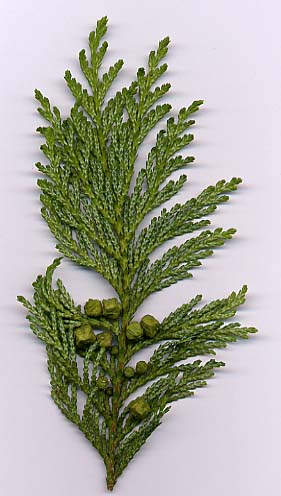Chamaecyparis
Chamaecyparis is a genus of conifers in the Cupressaceae family, commonly known as cypresses. The genus is native to eastern Asia and western and eastern North America. Members of this genus are widely cultivated for their attractive foliage and for use in landscaping. Despite their common name, they are not true cypresses (genus Cupressus). The trees vary in size and form but are generally evergreen and have small, scale-like leaves and spherical cones.
Description[edit | edit source]
Chamaecyparis trees are medium-sized to large, ranging from 20 to 70 meters in height. Their leaves are arranged in decussate pairs and are tightly pressed against the twig in overlapping scales. The bark of these trees is often reddish-brown and peels off in thin strips. The cones are small, globular, and mature in about 6-8 months; they have several scales, each bearing 1-2 seeds. The seeds are winged, aiding in their dispersal by wind.
Species[edit | edit source]
There are several species within the Chamaecyparis genus, including:
- Chamaecyparis lawsoniana (Lawson's Cypress or Port Orford Cedar), native to Oregon and California.
- Chamaecyparis obtusa (Hinoki Cypress), from Japan.
- Chamaecyparis pisifera (Sawara Cypress), also from Japan.
- Chamaecyparis thyoides (Atlantic White Cedar), found on the east coast of the United States.
Each species has its own unique characteristics and habitat requirements, but all share the common features of the Chamaecyparis genus.
Cultivation and Uses[edit | edit source]
Chamaecyparis species are popular in horticulture and are used extensively in gardens and parks for their aesthetic appeal. They are valued for their evergreen foliage, which can come in various colors, including green, blue, and yellow, depending on the cultivar. These trees are also used for timber and the production of essential oils. The wood is lightweight, resistant to rot, and highly valued for construction, particularly in East Asia for building temples and shrines.
Conservation[edit | edit source]
Some species of Chamaecyparis are considered threatened or endangered in their natural habitats due to overharvesting, habitat destruction, and disease. Conservation efforts are in place to protect these species and their habitats, including the establishment of protected areas and the promotion of sustainable forestry practices.
Gallery[edit | edit source]
Chamaecyparis species are notable for their beauty and variety. A gallery section would typically showcase images of different species, highlighting their foliage, cones, and overall form. However, images are not included in this format.
See Also[edit | edit source]
Search WikiMD
Ad.Tired of being Overweight? Try W8MD's NYC physician weight loss.
Semaglutide (Ozempic / Wegovy and Tirzepatide (Mounjaro / Zepbound) available. Call 718 946 5500.
Advertise on WikiMD
|
WikiMD's Wellness Encyclopedia |
| Let Food Be Thy Medicine Medicine Thy Food - Hippocrates |
Translate this page: - East Asian
中文,
日本,
한국어,
South Asian
हिन्दी,
தமிழ்,
తెలుగు,
Urdu,
ಕನ್ನಡ,
Southeast Asian
Indonesian,
Vietnamese,
Thai,
မြန်မာဘာသာ,
বাংলা
European
español,
Deutsch,
français,
Greek,
português do Brasil,
polski,
română,
русский,
Nederlands,
norsk,
svenska,
suomi,
Italian
Middle Eastern & African
عربى,
Turkish,
Persian,
Hebrew,
Afrikaans,
isiZulu,
Kiswahili,
Other
Bulgarian,
Hungarian,
Czech,
Swedish,
മലയാളം,
मराठी,
ਪੰਜਾਬੀ,
ગુજરાતી,
Portuguese,
Ukrainian
Medical Disclaimer: WikiMD is not a substitute for professional medical advice. The information on WikiMD is provided as an information resource only, may be incorrect, outdated or misleading, and is not to be used or relied on for any diagnostic or treatment purposes. Please consult your health care provider before making any healthcare decisions or for guidance about a specific medical condition. WikiMD expressly disclaims responsibility, and shall have no liability, for any damages, loss, injury, or liability whatsoever suffered as a result of your reliance on the information contained in this site. By visiting this site you agree to the foregoing terms and conditions, which may from time to time be changed or supplemented by WikiMD. If you do not agree to the foregoing terms and conditions, you should not enter or use this site. See full disclaimer.
Credits:Most images are courtesy of Wikimedia commons, and templates, categories Wikipedia, licensed under CC BY SA or similar.
Contributors: Prab R. Tumpati, MD

